Little Dessert Shop: Partnership, Porter's 5 Forces, and Macro Factors
VerifiedAdded on 2023/01/05
|8
|1984
|38
Report
AI Summary
This report examines the business strategy of 'Little Dessert Shop', focusing on its partnership structure, competitive advantages, and the influence of macro-environmental factors. The analysis begins with an evaluation of the partnership between Mary and Sue, exploring its advantages, such as ease of formation and resource availability, and disadvantages, including unlimited liability. The report then applies Porter's Five Forces model to assess the competitive landscape, considering factors such as buyer and supplier power, the threat of substitutes and new entrants, and competitive rivalry within the dessert shop market. Finally, it discusses how social, technological, and environmental factors can be leveraged to improve business operations, emphasizing the importance of adapting to customer preferences for healthy options, utilizing online ordering systems, and adopting eco-friendly practices. The report concludes that while partnership offers benefits like reduced risk, the business should focus on limited liability agreements and technological advancements to thrive.
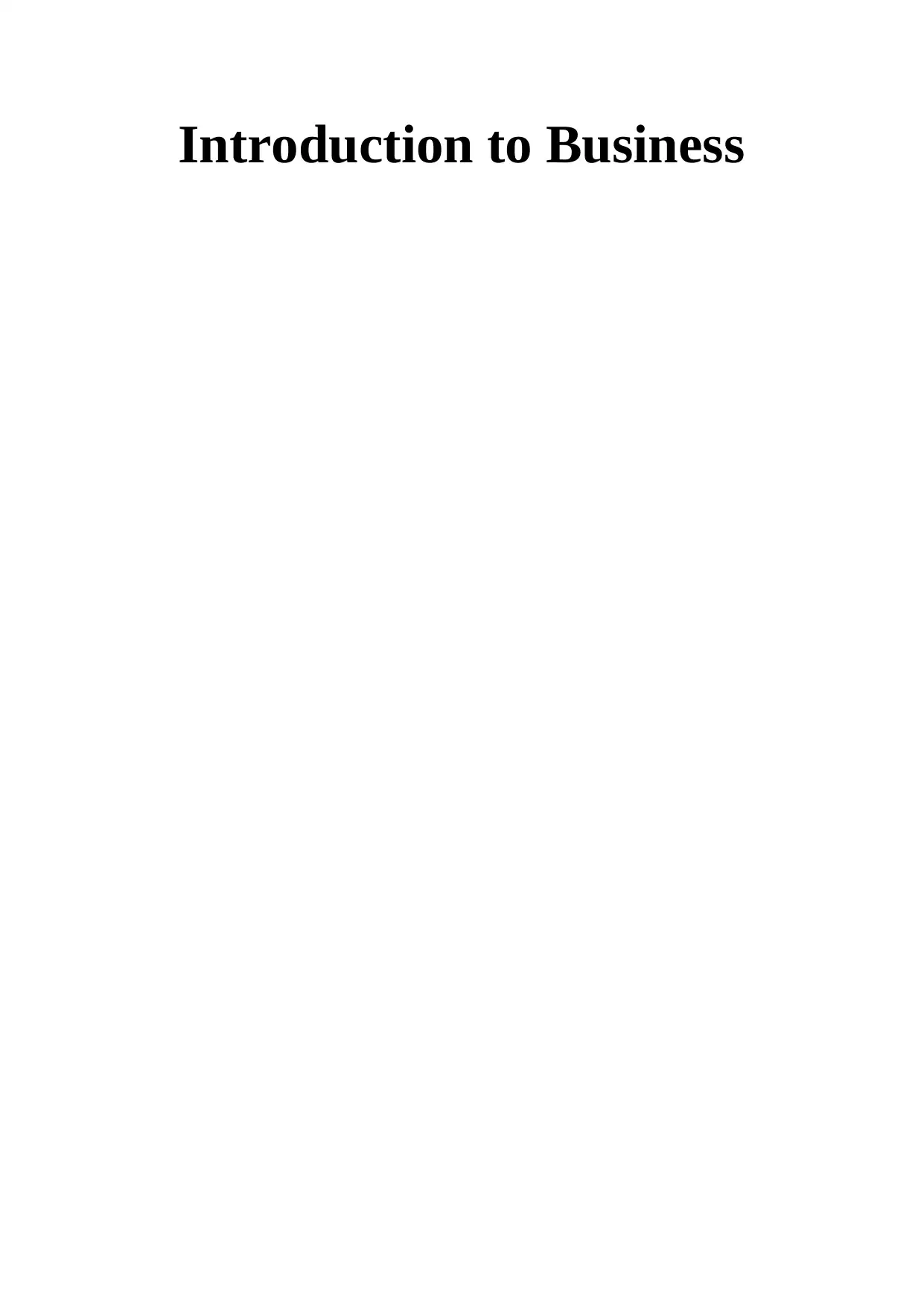
Introduction to Business
Paraphrase This Document
Need a fresh take? Get an instant paraphrase of this document with our AI Paraphraser
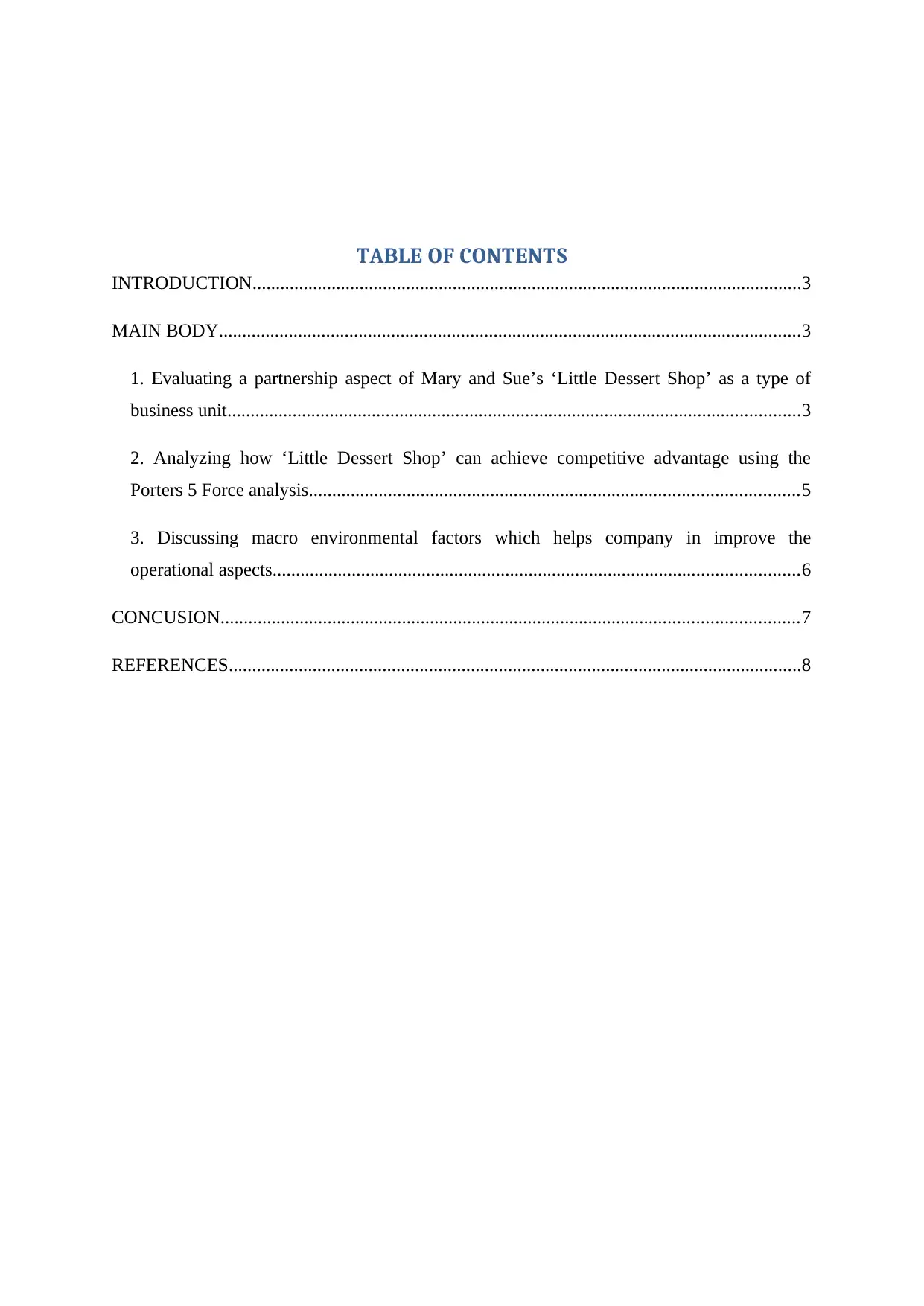
TABLE OF CONTENTS
INTRODUCTION......................................................................................................................3
MAIN BODY.............................................................................................................................3
1. Evaluating a partnership aspect of Mary and Sue’s ‘Little Dessert Shop’ as a type of
business unit...........................................................................................................................3
2. Analyzing how ‘Little Dessert Shop’ can achieve competitive advantage using the
Porters 5 Force analysis.........................................................................................................5
3. Discussing macro environmental factors which helps company in improve the
operational aspects.................................................................................................................6
CONCUSION............................................................................................................................7
REFERENCES...........................................................................................................................8
INTRODUCTION......................................................................................................................3
MAIN BODY.............................................................................................................................3
1. Evaluating a partnership aspect of Mary and Sue’s ‘Little Dessert Shop’ as a type of
business unit...........................................................................................................................3
2. Analyzing how ‘Little Dessert Shop’ can achieve competitive advantage using the
Porters 5 Force analysis.........................................................................................................5
3. Discussing macro environmental factors which helps company in improve the
operational aspects.................................................................................................................6
CONCUSION............................................................................................................................7
REFERENCES...........................................................................................................................8
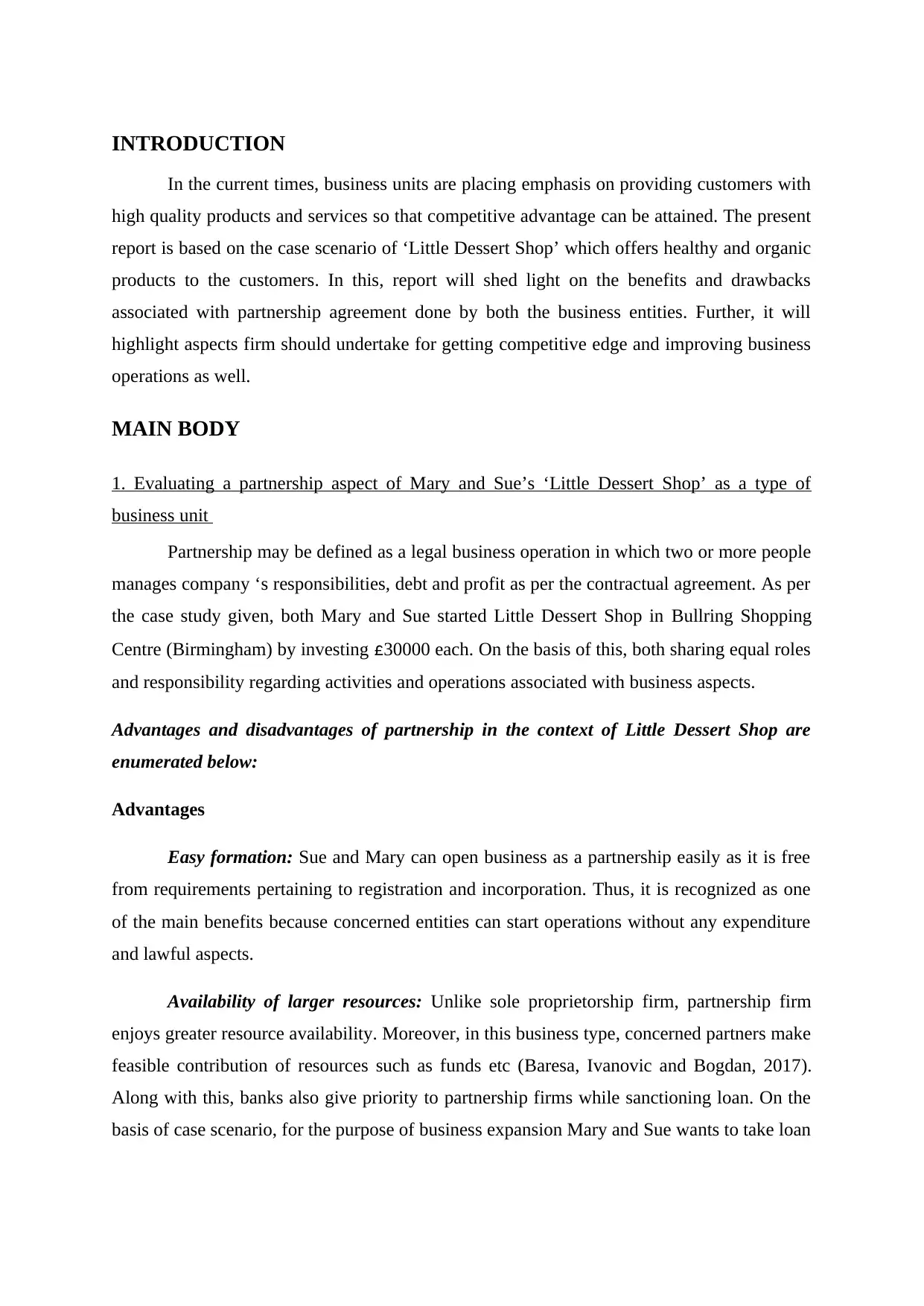
INTRODUCTION
In the current times, business units are placing emphasis on providing customers with
high quality products and services so that competitive advantage can be attained. The present
report is based on the case scenario of ‘Little Dessert Shop’ which offers healthy and organic
products to the customers. In this, report will shed light on the benefits and drawbacks
associated with partnership agreement done by both the business entities. Further, it will
highlight aspects firm should undertake for getting competitive edge and improving business
operations as well.
MAIN BODY
1. Evaluating a partnership aspect of Mary and Sue’s ‘Little Dessert Shop’ as a type of
business unit
Partnership may be defined as a legal business operation in which two or more people
manages company ‘s responsibilities, debt and profit as per the contractual agreement. As per
the case study given, both Mary and Sue started Little Dessert Shop in Bullring Shopping
Centre (Birmingham) by investing £30000 each. On the basis of this, both sharing equal roles
and responsibility regarding activities and operations associated with business aspects.
Advantages and disadvantages of partnership in the context of Little Dessert Shop are
enumerated below:
Advantages
Easy formation: Sue and Mary can open business as a partnership easily as it is free
from requirements pertaining to registration and incorporation. Thus, it is recognized as one
of the main benefits because concerned entities can start operations without any expenditure
and lawful aspects.
Availability of larger resources: Unlike sole proprietorship firm, partnership firm
enjoys greater resource availability. Moreover, in this business type, concerned partners make
feasible contribution of resources such as funds etc (Baresa, Ivanovic and Bogdan, 2017).
Along with this, banks also give priority to partnership firms while sanctioning loan. On the
basis of case scenario, for the purpose of business expansion Mary and Sue wants to take loan
In the current times, business units are placing emphasis on providing customers with
high quality products and services so that competitive advantage can be attained. The present
report is based on the case scenario of ‘Little Dessert Shop’ which offers healthy and organic
products to the customers. In this, report will shed light on the benefits and drawbacks
associated with partnership agreement done by both the business entities. Further, it will
highlight aspects firm should undertake for getting competitive edge and improving business
operations as well.
MAIN BODY
1. Evaluating a partnership aspect of Mary and Sue’s ‘Little Dessert Shop’ as a type of
business unit
Partnership may be defined as a legal business operation in which two or more people
manages company ‘s responsibilities, debt and profit as per the contractual agreement. As per
the case study given, both Mary and Sue started Little Dessert Shop in Bullring Shopping
Centre (Birmingham) by investing £30000 each. On the basis of this, both sharing equal roles
and responsibility regarding activities and operations associated with business aspects.
Advantages and disadvantages of partnership in the context of Little Dessert Shop are
enumerated below:
Advantages
Easy formation: Sue and Mary can open business as a partnership easily as it is free
from requirements pertaining to registration and incorporation. Thus, it is recognized as one
of the main benefits because concerned entities can start operations without any expenditure
and lawful aspects.
Availability of larger resources: Unlike sole proprietorship firm, partnership firm
enjoys greater resource availability. Moreover, in this business type, concerned partners make
feasible contribution of resources such as funds etc (Baresa, Ivanovic and Bogdan, 2017).
Along with this, banks also give priority to partnership firms while sanctioning loan. On the
basis of case scenario, for the purpose of business expansion Mary and Sue wants to take loan
⊘ This is a preview!⊘
Do you want full access?
Subscribe today to unlock all pages.

Trusted by 1+ million students worldwide
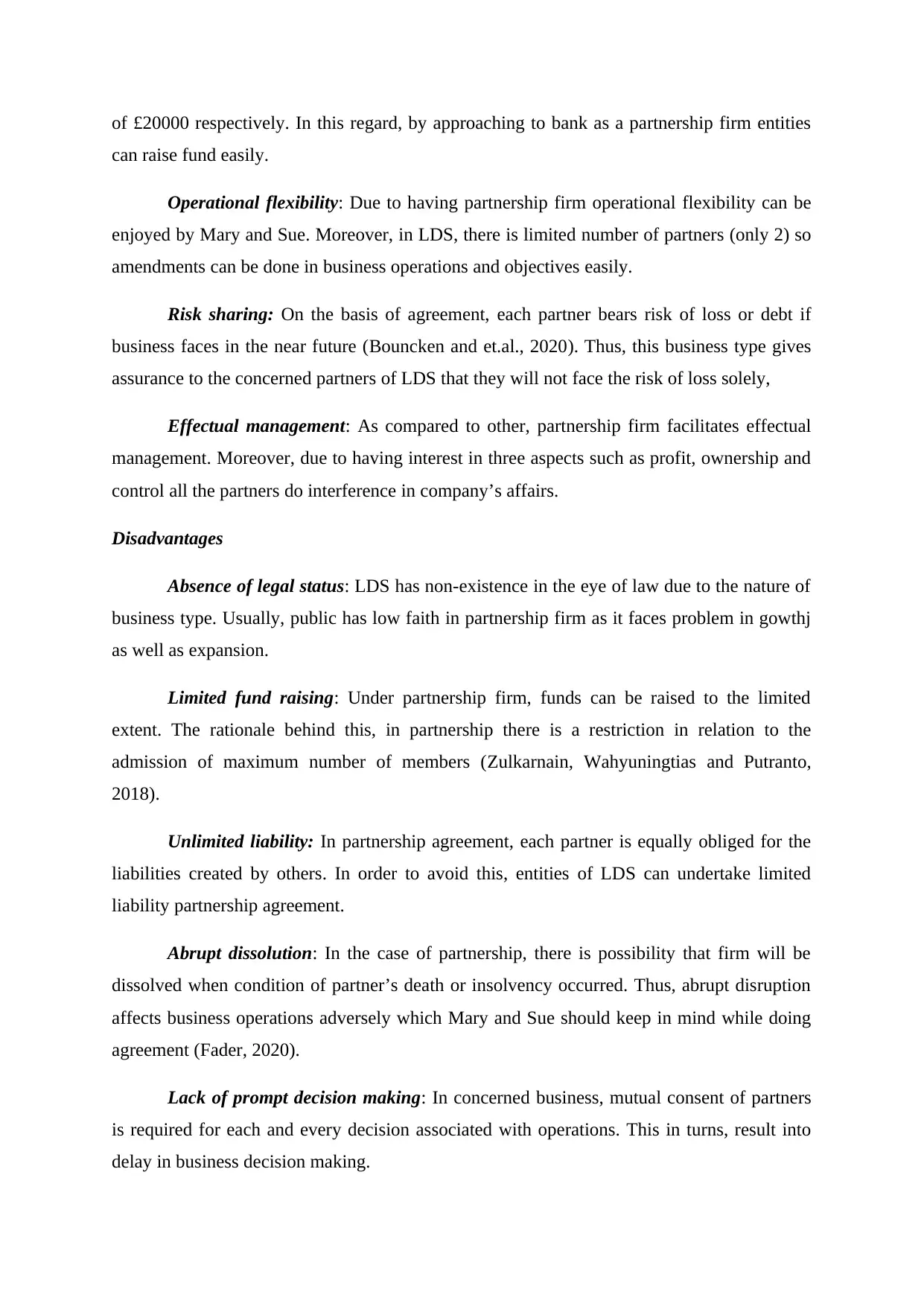
of £20000 respectively. In this regard, by approaching to bank as a partnership firm entities
can raise fund easily.
Operational flexibility: Due to having partnership firm operational flexibility can be
enjoyed by Mary and Sue. Moreover, in LDS, there is limited number of partners (only 2) so
amendments can be done in business operations and objectives easily.
Risk sharing: On the basis of agreement, each partner bears risk of loss or debt if
business faces in the near future (Bouncken and et.al., 2020). Thus, this business type gives
assurance to the concerned partners of LDS that they will not face the risk of loss solely,
Effectual management: As compared to other, partnership firm facilitates effectual
management. Moreover, due to having interest in three aspects such as profit, ownership and
control all the partners do interference in company’s affairs.
Disadvantages
Absence of legal status: LDS has non-existence in the eye of law due to the nature of
business type. Usually, public has low faith in partnership firm as it faces problem in gowthj
as well as expansion.
Limited fund raising: Under partnership firm, funds can be raised to the limited
extent. The rationale behind this, in partnership there is a restriction in relation to the
admission of maximum number of members (Zulkarnain, Wahyuningtias and Putranto,
2018).
Unlimited liability: In partnership agreement, each partner is equally obliged for the
liabilities created by others. In order to avoid this, entities of LDS can undertake limited
liability partnership agreement.
Abrupt dissolution: In the case of partnership, there is possibility that firm will be
dissolved when condition of partner’s death or insolvency occurred. Thus, abrupt disruption
affects business operations adversely which Mary and Sue should keep in mind while doing
agreement (Fader, 2020).
Lack of prompt decision making: In concerned business, mutual consent of partners
is required for each and every decision associated with operations. This in turns, result into
delay in business decision making.
can raise fund easily.
Operational flexibility: Due to having partnership firm operational flexibility can be
enjoyed by Mary and Sue. Moreover, in LDS, there is limited number of partners (only 2) so
amendments can be done in business operations and objectives easily.
Risk sharing: On the basis of agreement, each partner bears risk of loss or debt if
business faces in the near future (Bouncken and et.al., 2020). Thus, this business type gives
assurance to the concerned partners of LDS that they will not face the risk of loss solely,
Effectual management: As compared to other, partnership firm facilitates effectual
management. Moreover, due to having interest in three aspects such as profit, ownership and
control all the partners do interference in company’s affairs.
Disadvantages
Absence of legal status: LDS has non-existence in the eye of law due to the nature of
business type. Usually, public has low faith in partnership firm as it faces problem in gowthj
as well as expansion.
Limited fund raising: Under partnership firm, funds can be raised to the limited
extent. The rationale behind this, in partnership there is a restriction in relation to the
admission of maximum number of members (Zulkarnain, Wahyuningtias and Putranto,
2018).
Unlimited liability: In partnership agreement, each partner is equally obliged for the
liabilities created by others. In order to avoid this, entities of LDS can undertake limited
liability partnership agreement.
Abrupt dissolution: In the case of partnership, there is possibility that firm will be
dissolved when condition of partner’s death or insolvency occurred. Thus, abrupt disruption
affects business operations adversely which Mary and Sue should keep in mind while doing
agreement (Fader, 2020).
Lack of prompt decision making: In concerned business, mutual consent of partners
is required for each and every decision associated with operations. This in turns, result into
delay in business decision making.
Paraphrase This Document
Need a fresh take? Get an instant paraphrase of this document with our AI Paraphraser
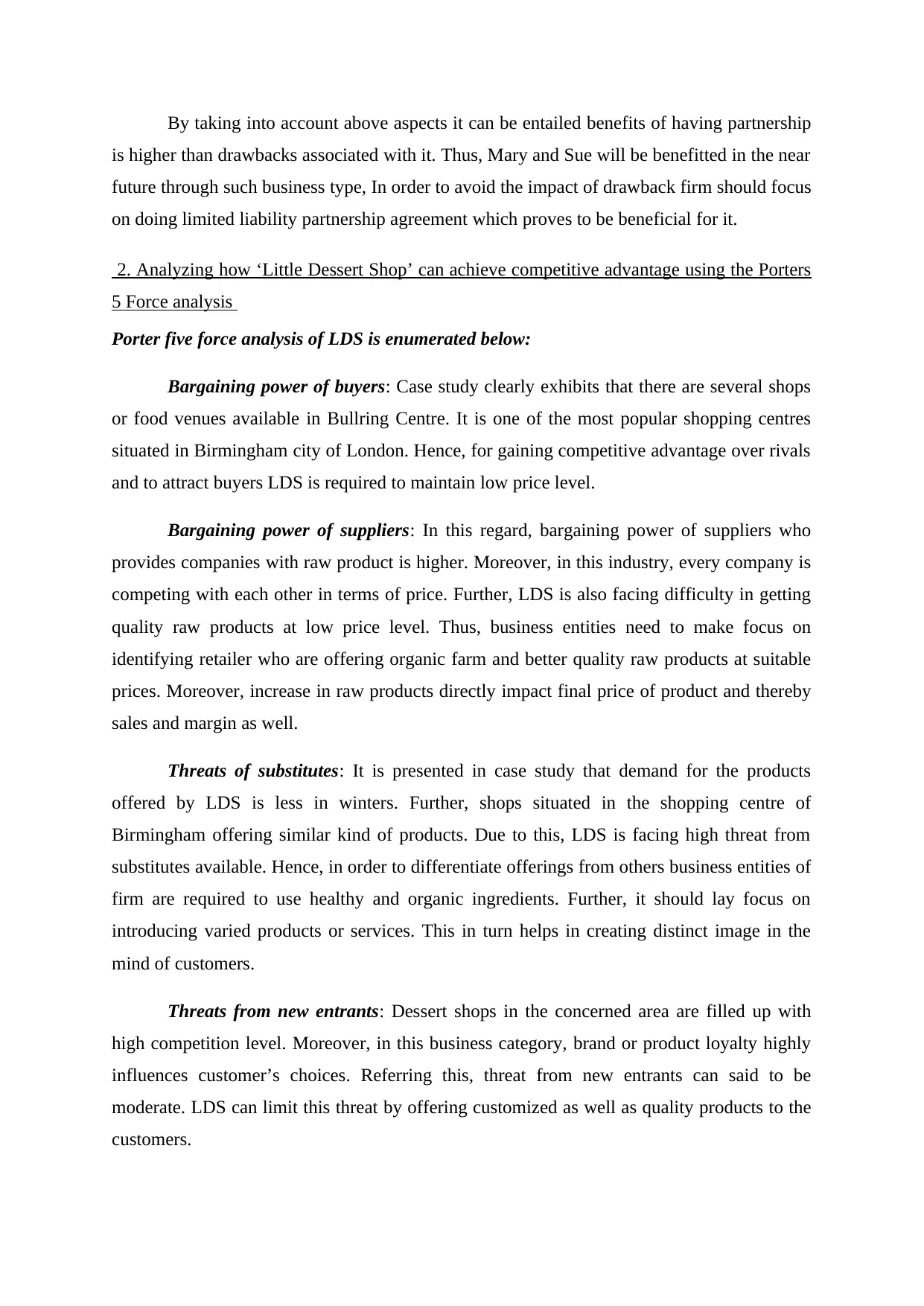
By taking into account above aspects it can be entailed benefits of having partnership
is higher than drawbacks associated with it. Thus, Mary and Sue will be benefitted in the near
future through such business type, In order to avoid the impact of drawback firm should focus
on doing limited liability partnership agreement which proves to be beneficial for it.
2. Analyzing how ‘Little Dessert Shop’ can achieve competitive advantage using the Porters
5 Force analysis
Porter five force analysis of LDS is enumerated below:
Bargaining power of buyers: Case study clearly exhibits that there are several shops
or food venues available in Bullring Centre. It is one of the most popular shopping centres
situated in Birmingham city of London. Hence, for gaining competitive advantage over rivals
and to attract buyers LDS is required to maintain low price level.
Bargaining power of suppliers: In this regard, bargaining power of suppliers who
provides companies with raw product is higher. Moreover, in this industry, every company is
competing with each other in terms of price. Further, LDS is also facing difficulty in getting
quality raw products at low price level. Thus, business entities need to make focus on
identifying retailer who are offering organic farm and better quality raw products at suitable
prices. Moreover, increase in raw products directly impact final price of product and thereby
sales and margin as well.
Threats of substitutes: It is presented in case study that demand for the products
offered by LDS is less in winters. Further, shops situated in the shopping centre of
Birmingham offering similar kind of products. Due to this, LDS is facing high threat from
substitutes available. Hence, in order to differentiate offerings from others business entities of
firm are required to use healthy and organic ingredients. Further, it should lay focus on
introducing varied products or services. This in turn helps in creating distinct image in the
mind of customers.
Threats from new entrants: Dessert shops in the concerned area are filled up with
high competition level. Moreover, in this business category, brand or product loyalty highly
influences customer’s choices. Referring this, threat from new entrants can said to be
moderate. LDS can limit this threat by offering customized as well as quality products to the
customers.
is higher than drawbacks associated with it. Thus, Mary and Sue will be benefitted in the near
future through such business type, In order to avoid the impact of drawback firm should focus
on doing limited liability partnership agreement which proves to be beneficial for it.
2. Analyzing how ‘Little Dessert Shop’ can achieve competitive advantage using the Porters
5 Force analysis
Porter five force analysis of LDS is enumerated below:
Bargaining power of buyers: Case study clearly exhibits that there are several shops
or food venues available in Bullring Centre. It is one of the most popular shopping centres
situated in Birmingham city of London. Hence, for gaining competitive advantage over rivals
and to attract buyers LDS is required to maintain low price level.
Bargaining power of suppliers: In this regard, bargaining power of suppliers who
provides companies with raw product is higher. Moreover, in this industry, every company is
competing with each other in terms of price. Further, LDS is also facing difficulty in getting
quality raw products at low price level. Thus, business entities need to make focus on
identifying retailer who are offering organic farm and better quality raw products at suitable
prices. Moreover, increase in raw products directly impact final price of product and thereby
sales and margin as well.
Threats of substitutes: It is presented in case study that demand for the products
offered by LDS is less in winters. Further, shops situated in the shopping centre of
Birmingham offering similar kind of products. Due to this, LDS is facing high threat from
substitutes available. Hence, in order to differentiate offerings from others business entities of
firm are required to use healthy and organic ingredients. Further, it should lay focus on
introducing varied products or services. This in turn helps in creating distinct image in the
mind of customers.
Threats from new entrants: Dessert shops in the concerned area are filled up with
high competition level. Moreover, in this business category, brand or product loyalty highly
influences customer’s choices. Referring this, threat from new entrants can said to be
moderate. LDS can limit this threat by offering customized as well as quality products to the
customers.
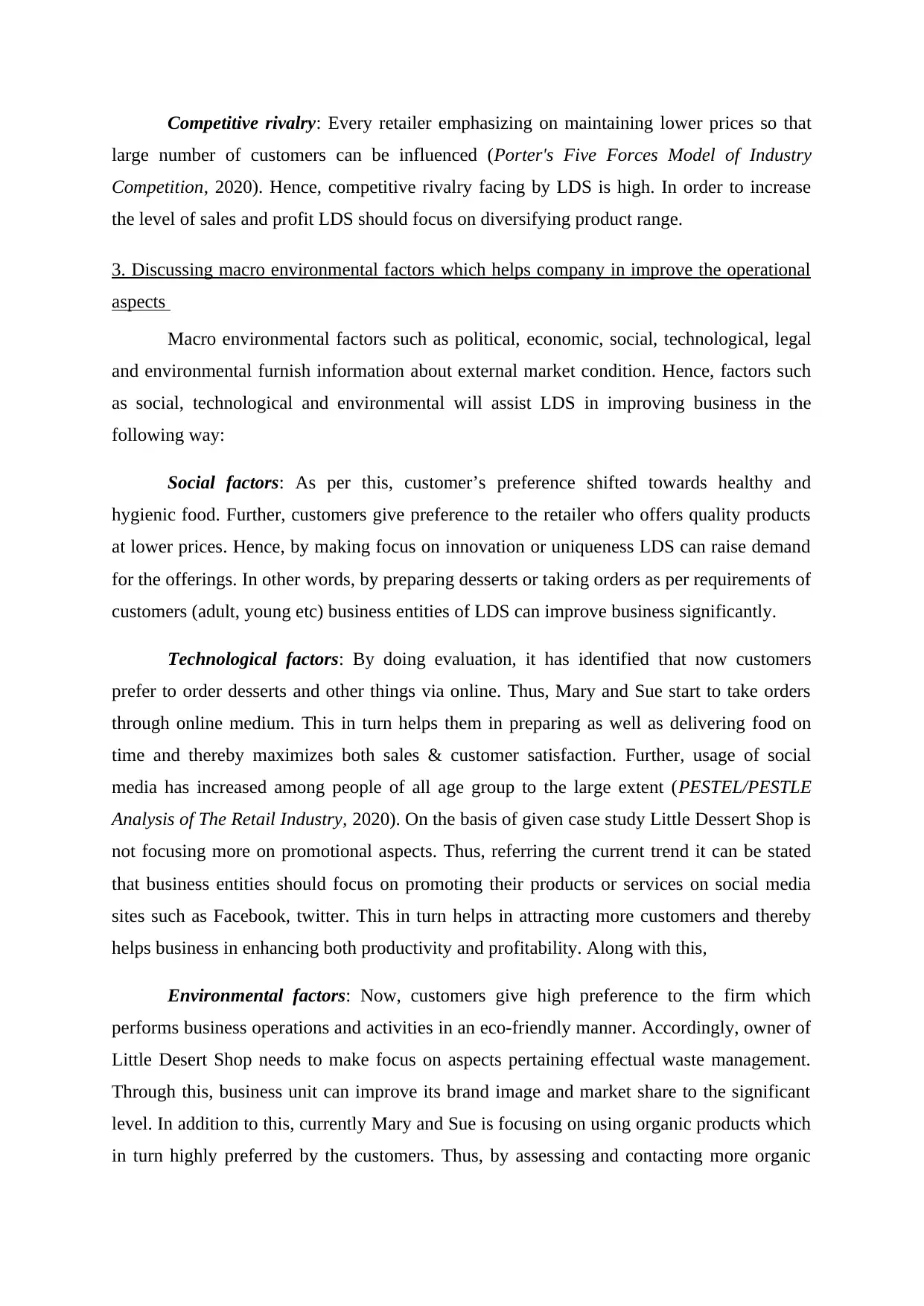
Competitive rivalry: Every retailer emphasizing on maintaining lower prices so that
large number of customers can be influenced (Porter's Five Forces Model of Industry
Competition, 2020). Hence, competitive rivalry facing by LDS is high. In order to increase
the level of sales and profit LDS should focus on diversifying product range.
3. Discussing macro environmental factors which helps company in improve the operational
aspects
Macro environmental factors such as political, economic, social, technological, legal
and environmental furnish information about external market condition. Hence, factors such
as social, technological and environmental will assist LDS in improving business in the
following way:
Social factors: As per this, customer’s preference shifted towards healthy and
hygienic food. Further, customers give preference to the retailer who offers quality products
at lower prices. Hence, by making focus on innovation or uniqueness LDS can raise demand
for the offerings. In other words, by preparing desserts or taking orders as per requirements of
customers (adult, young etc) business entities of LDS can improve business significantly.
Technological factors: By doing evaluation, it has identified that now customers
prefer to order desserts and other things via online. Thus, Mary and Sue start to take orders
through online medium. This in turn helps them in preparing as well as delivering food on
time and thereby maximizes both sales & customer satisfaction. Further, usage of social
media has increased among people of all age group to the large extent (PESTEL/PESTLE
Analysis of The Retail Industry, 2020). On the basis of given case study Little Dessert Shop is
not focusing more on promotional aspects. Thus, referring the current trend it can be stated
that business entities should focus on promoting their products or services on social media
sites such as Facebook, twitter. This in turn helps in attracting more customers and thereby
helps business in enhancing both productivity and profitability. Along with this,
Environmental factors: Now, customers give high preference to the firm which
performs business operations and activities in an eco-friendly manner. Accordingly, owner of
Little Desert Shop needs to make focus on aspects pertaining effectual waste management.
Through this, business unit can improve its brand image and market share to the significant
level. In addition to this, currently Mary and Sue is focusing on using organic products which
in turn highly preferred by the customers. Thus, by assessing and contacting more organic
large number of customers can be influenced (Porter's Five Forces Model of Industry
Competition, 2020). Hence, competitive rivalry facing by LDS is high. In order to increase
the level of sales and profit LDS should focus on diversifying product range.
3. Discussing macro environmental factors which helps company in improve the operational
aspects
Macro environmental factors such as political, economic, social, technological, legal
and environmental furnish information about external market condition. Hence, factors such
as social, technological and environmental will assist LDS in improving business in the
following way:
Social factors: As per this, customer’s preference shifted towards healthy and
hygienic food. Further, customers give preference to the retailer who offers quality products
at lower prices. Hence, by making focus on innovation or uniqueness LDS can raise demand
for the offerings. In other words, by preparing desserts or taking orders as per requirements of
customers (adult, young etc) business entities of LDS can improve business significantly.
Technological factors: By doing evaluation, it has identified that now customers
prefer to order desserts and other things via online. Thus, Mary and Sue start to take orders
through online medium. This in turn helps them in preparing as well as delivering food on
time and thereby maximizes both sales & customer satisfaction. Further, usage of social
media has increased among people of all age group to the large extent (PESTEL/PESTLE
Analysis of The Retail Industry, 2020). On the basis of given case study Little Dessert Shop is
not focusing more on promotional aspects. Thus, referring the current trend it can be stated
that business entities should focus on promoting their products or services on social media
sites such as Facebook, twitter. This in turn helps in attracting more customers and thereby
helps business in enhancing both productivity and profitability. Along with this,
Environmental factors: Now, customers give high preference to the firm which
performs business operations and activities in an eco-friendly manner. Accordingly, owner of
Little Desert Shop needs to make focus on aspects pertaining effectual waste management.
Through this, business unit can improve its brand image and market share to the significant
level. In addition to this, currently Mary and Sue is focusing on using organic products which
in turn highly preferred by the customers. Thus, by assessing and contacting more organic
⊘ This is a preview!⊘
Do you want full access?
Subscribe today to unlock all pages.

Trusted by 1+ million students worldwide
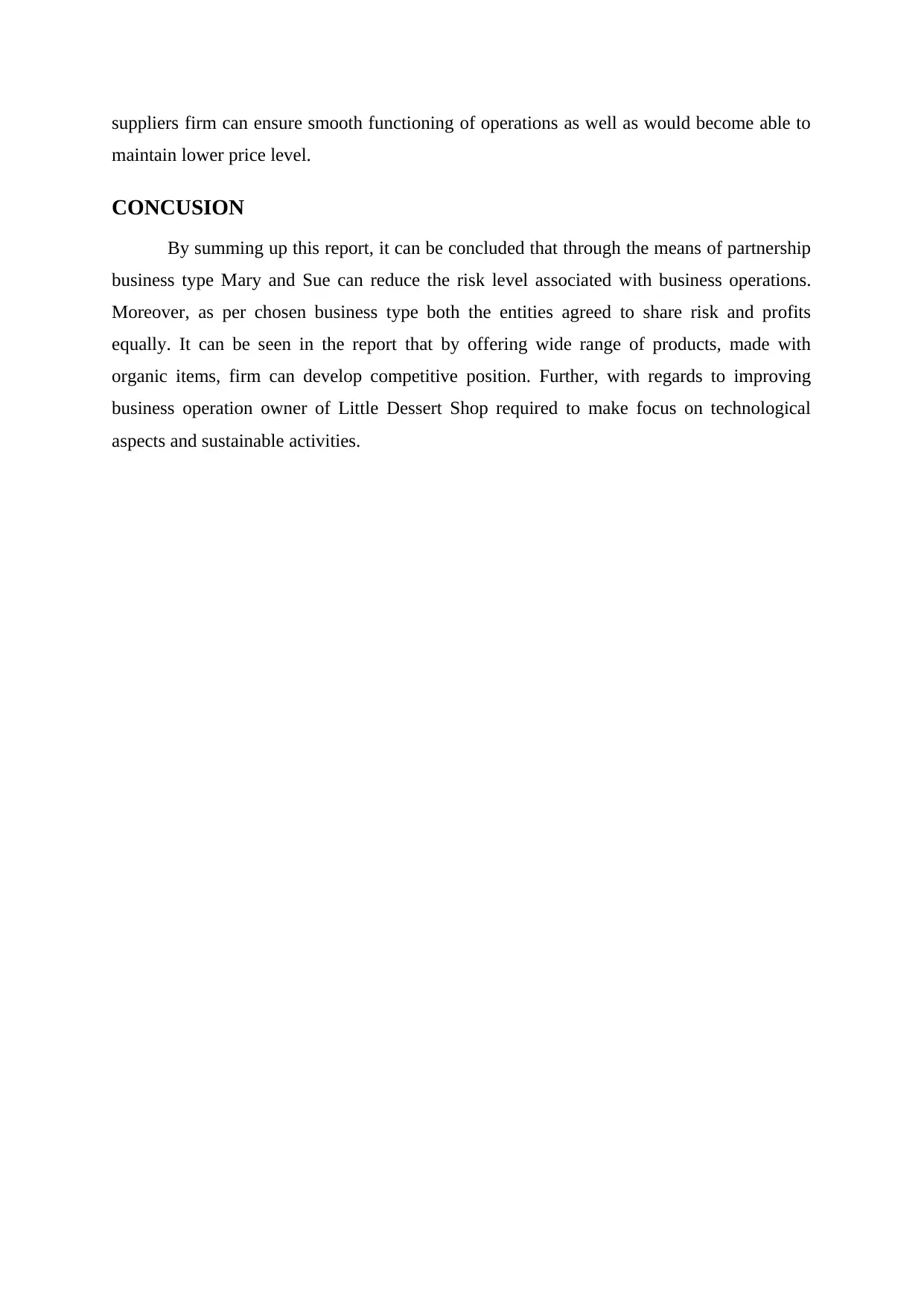
suppliers firm can ensure smooth functioning of operations as well as would become able to
maintain lower price level.
CONCUSION
By summing up this report, it can be concluded that through the means of partnership
business type Mary and Sue can reduce the risk level associated with business operations.
Moreover, as per chosen business type both the entities agreed to share risk and profits
equally. It can be seen in the report that by offering wide range of products, made with
organic items, firm can develop competitive position. Further, with regards to improving
business operation owner of Little Dessert Shop required to make focus on technological
aspects and sustainable activities.
maintain lower price level.
CONCUSION
By summing up this report, it can be concluded that through the means of partnership
business type Mary and Sue can reduce the risk level associated with business operations.
Moreover, as per chosen business type both the entities agreed to share risk and profits
equally. It can be seen in the report that by offering wide range of products, made with
organic items, firm can develop competitive position. Further, with regards to improving
business operation owner of Little Dessert Shop required to make focus on technological
aspects and sustainable activities.
Paraphrase This Document
Need a fresh take? Get an instant paraphrase of this document with our AI Paraphraser
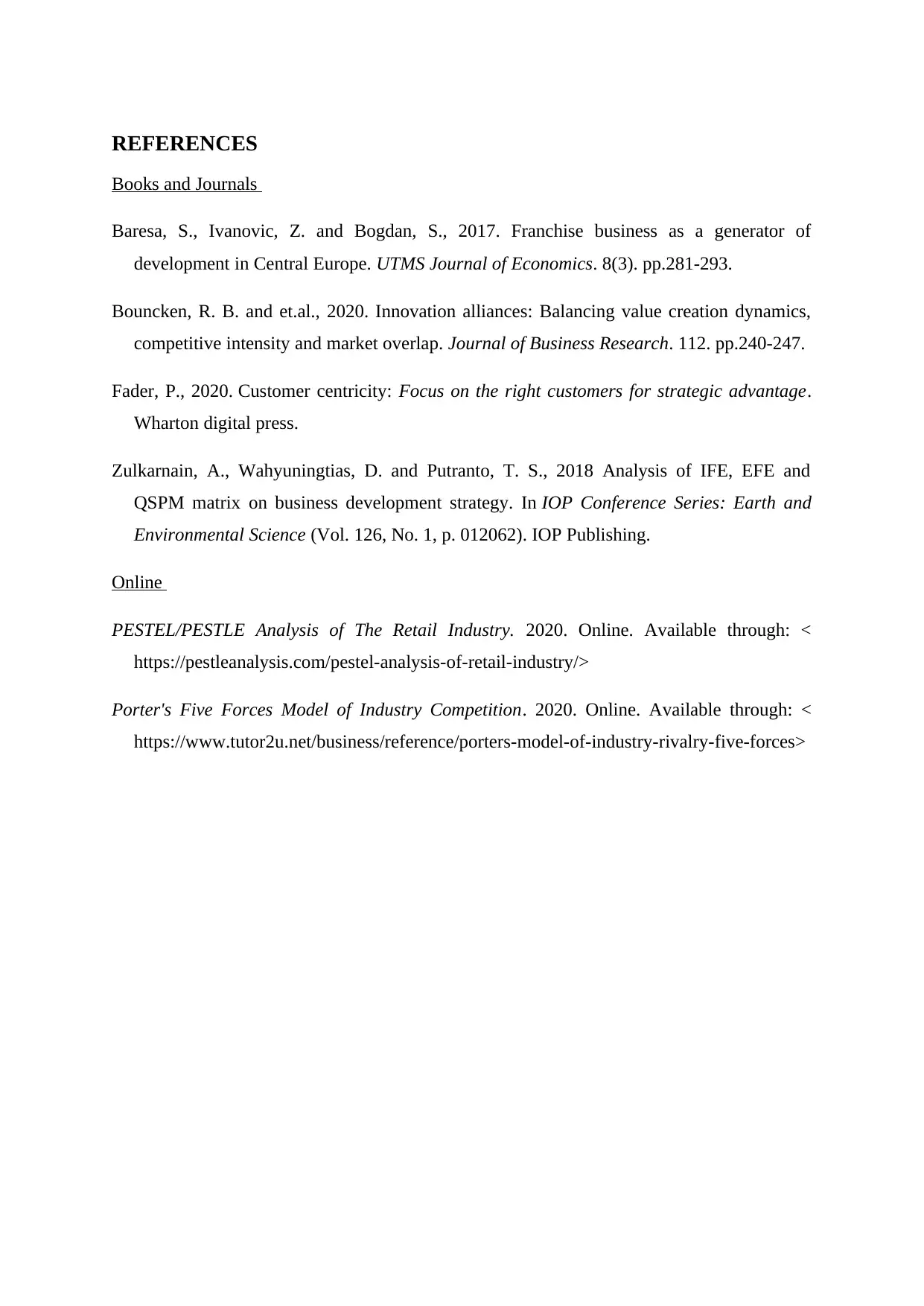
REFERENCES
Books and Journals
Baresa, S., Ivanovic, Z. and Bogdan, S., 2017. Franchise business as a generator of
development in Central Europe. UTMS Journal of Economics. 8(3). pp.281-293.
Bouncken, R. B. and et.al., 2020. Innovation alliances: Balancing value creation dynamics,
competitive intensity and market overlap. Journal of Business Research. 112. pp.240-247.
Fader, P., 2020. Customer centricity: Focus on the right customers for strategic advantage.
Wharton digital press.
Zulkarnain, A., Wahyuningtias, D. and Putranto, T. S., 2018 Analysis of IFE, EFE and
QSPM matrix on business development strategy. In IOP Conference Series: Earth and
Environmental Science (Vol. 126, No. 1, p. 012062). IOP Publishing.
Online
PESTEL/PESTLE Analysis of The Retail Industry. 2020. Online. Available through: <
https://pestleanalysis.com/pestel-analysis-of-retail-industry/>
Porter's Five Forces Model of Industry Competition. 2020. Online. Available through: <
https://www.tutor2u.net/business/reference/porters-model-of-industry-rivalry-five-forces>
Books and Journals
Baresa, S., Ivanovic, Z. and Bogdan, S., 2017. Franchise business as a generator of
development in Central Europe. UTMS Journal of Economics. 8(3). pp.281-293.
Bouncken, R. B. and et.al., 2020. Innovation alliances: Balancing value creation dynamics,
competitive intensity and market overlap. Journal of Business Research. 112. pp.240-247.
Fader, P., 2020. Customer centricity: Focus on the right customers for strategic advantage.
Wharton digital press.
Zulkarnain, A., Wahyuningtias, D. and Putranto, T. S., 2018 Analysis of IFE, EFE and
QSPM matrix on business development strategy. In IOP Conference Series: Earth and
Environmental Science (Vol. 126, No. 1, p. 012062). IOP Publishing.
Online
PESTEL/PESTLE Analysis of The Retail Industry. 2020. Online. Available through: <
https://pestleanalysis.com/pestel-analysis-of-retail-industry/>
Porter's Five Forces Model of Industry Competition. 2020. Online. Available through: <
https://www.tutor2u.net/business/reference/porters-model-of-industry-rivalry-five-forces>
1 out of 8
Related Documents
Your All-in-One AI-Powered Toolkit for Academic Success.
+13062052269
info@desklib.com
Available 24*7 on WhatsApp / Email
![[object Object]](/_next/static/media/star-bottom.7253800d.svg)
Unlock your academic potential
Copyright © 2020–2025 A2Z Services. All Rights Reserved. Developed and managed by ZUCOL.





